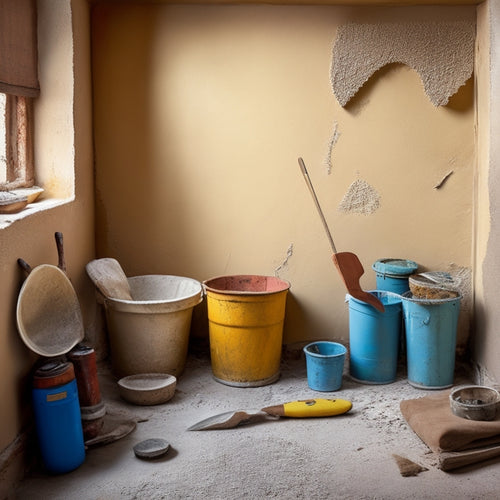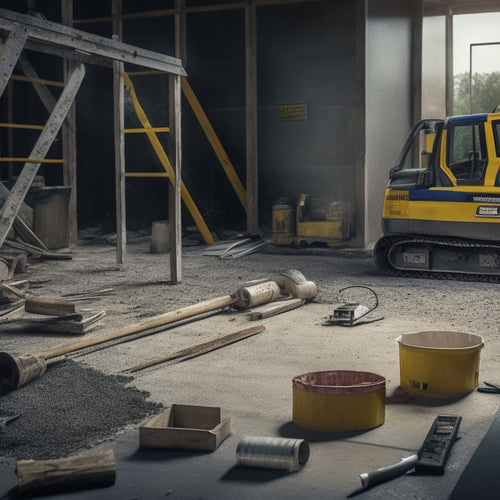
Essential Mixing Tool Accessories for DIY Home Renovators
Share
When tackling a DIY home renovation project, you'll need a range of essential mixing tool accessories to get the job done efficiently and safely. From heavy-duty buckets and paddles to ergonomic handles and cleaning solutions, each tool is designed to improve the quality of your concrete mix. You'll also want to contemplate bucket lid and screen accessories, heavy-duty mixing drill bits, and wheelbarrow mixing tool adapters to streamline your workflow. By investing in these accessories, you'll be well on your way to achieving professional results - and with the right knowledge, you'll be able to mix like a pro and take your project to the next level.
Key Takeaways
• Choose the right mixing bucket and paddle size for your project to ensure efficient and safe mixing.
• Wear protective gear, including gloves and safety glasses, to prevent injury while mixing.
• Upgrade your mixing tools with ergonomic handle attachments for improved control and reduced fatigue.
• Clean and sanitize your mixing tools regularly to prevent contamination and ensure project quality.
• Invest in a variety of mixing tool accessories, such as bucket lids and screens, to enhance efficiency and performance.
Mixing Bucket Essentials
When tackling a DIY home renovation project, you'll likely find yourself reaching for a trusty mixing bucket more often than not, making it vital to stock it with the right tools and accessories to confirm efficient and effective mixing.
First, it's important to choose the right mixing bucket type for your project. You have options ranging from heavy-duty, thick-walled buckets for heavy mixing tasks to lighter, more portable ones for smaller jobs. Consider the size, material, and durability of the bucket to ascertain it can withstand the demands of your project.
Verify bucket safety by following essential safety tips. Always place the bucket on a level, stable surface to prevent spills and accidents. Wear protective gear like gloves and safety glasses when mixing, and avoid overreaching or bending while handling heavy materials.
Keep the bucket clean and dry to prevent slipping hazards, and never leave it unattended with mixing tools or materials inside.
Concrete Mixing Paddle Options
With your mixing bucket prepared and safety protocols in place, you'll need a reliable concrete mixing paddle to efficiently blend your materials and achieve a smooth, consistent finish. The right paddle can make all the difference in the quality of your concrete mix. When selecting a paddle, consider the material type and size variation that best suits your project needs.
| Paddle Material Types | Characteristics |
|---|---|
| Fiberglass | Lightweight, resistant to corrosion, and easy to clean |
| Steel | Heavy-duty, durable, and provides maximum mixing power |
| Polymer | Chemical-resistant, non-abrasive, and ideal for mixing sensitive materials |
| Aluminum | Lightweight, corrosion-resistant, and suitable for general-purpose mixing |
| Wooden | Traditional, cost-effective, and suitable for small-scale mixing projects |
Choose from a range of paddle size variations, from compact 12-inch paddles for small batches to larger 24-inch paddles for bigger projects. Consider the size of your mixing bucket and the type of materials you're working with to select the best paddle size. By selecting the right paddle material and size, you'll be well on your way to achieving a professional-grade concrete mix.
Ergonomic Handle Attachments
As you consider ergonomic handle attachments for your mixing tools, you'll want to explore grip enhancement options that provide a secure hold, even in wet or slippery conditions.
You'll also appreciate reduced fatigue designs that redistribute the weight of the tool, allowing you to work longer without strain.
Additionally, adjustable angle features will give you the flexibility to customize the handle's position to your comfort, reducing strain on your wrists and hands.
Grip Enhancement Options
You can upgrade your mixing tools with ergonomic handle attachments that provide grip enhancement options, allowing you to tackle DIY home renovation projects with improved control and reduced fatigue.
By incorporating grip enhancement features, you'll experience a more secure hold, even with sweaty or gloved hands. One popular option is grip tape, which provides a textured surface for a firmer grasp. This is particularly useful for mixing tools with smooth handles, where slippage can be a concern.
Alternatively, rubber grips can be attached to the handle, offering a cushioned surface that absorbs shock and vibration. This reduces the impact on your hands and wrists, making it ideal for prolonged use.
When selecting grip enhancement options, consider the material and texture that best suits your needs. For example, if you work in humid environments, a rubber grip might be more effective than grip tape.
Reduced Fatigue Designs
Ergonomic handle attachments featuring reduced fatigue designs can be integrated into your mixing tools to alleviate strain on your hands and wrists, allowing you to work for extended periods without discomfort.
As a DIY home renovator, you understand the importance of minimizing fatigue when working on projects that require prolonged mixing. That's where ergonomic handle attachments come in. These accessories are designed to reduce strain on your hands and wrists, enabling you to work more efficiently and effectively.
Here are some key features to look for in ergonomic handle attachments that promote fatigue reduction:
-
Contoured grips: Designed to fit comfortably in your hand, reducing pressure points and strain on your wrists.
-
Cushioned handles: Absorb vibrations and shocks, reducing the impact on your hands and wrists.
-
Angled handles: Allow for a more natural grip, reducing strain on your wrists and forearms.
- Balanced weight distribution: Guarantees that the weight of the mixing tool is evenly distributed, reducing fatigue and strain.
Adjustable Angle Features
Adjustable angle features integrated into ergonomic handle attachments enable you to customize the grip to fit your unique hand and wrist alignment, promoting ideal comfort and control during extended mixing tasks.
This innovative design allows you to adjust the angle of the mixer to accommodate your natural stance and movement, reducing strain on your joints and muscles. With adjustable angle features, you can achieve precise control over the mixing process, ensuring accurate results and minimizing the risk of errors.
When working with angle measurement tools, adjustable mixer stands, or other specialized equipment, adjustable angle features become even more vital. They enable you to adapt to different mixing scenarios and tasks, ensuring that you can work efficiently and effectively.
Mixing Tool Cleaning Solutions
When you're working on a DIY project, you'll need to guarantee your mixing tools are clean and sanitized to prevent the spread of contaminants and guarantee a successful outcome.
You'll want to develop effective cleaning methods that remove stubborn residue and grime, and understand the tool sanitizing essentials that'll keep your equipment in top condition.
Effective Cleaning Methods
You'll need a reliable cleaning solution to remove dried materials and residue from your mixing tools, ensuring they're in prime condition for your next DIY project. Effective cleaning methods are vital to maintaining the quality and performance of your tools.
Here are some essential cleaning techniques to keep in mind:
-
Soak and Scrub: Soak your mixing tools in warm soapy water for 30 minutes, then scrub off any remaining residue with a soft-bristled brush.
-
Vinegar and Water: Mix equal parts vinegar and water to create a solution that's effective at breaking down dried materials.
-
Baking Soda and Water: Create a paste by mixing baking soda and water, then apply it to the affected area and let it sit for 30 minutes before rinsing.
- Dry Thoroughly: After cleaning, dry your mixing tools thoroughly to prevent water spots and rust.
Tool Sanitizing Essentials
To guarantee your mixing tools remain hygienic and free of contaminants, it's crucial to utilize effective sanitizing solutions that can eliminate bacteria, viruses, and other microorganisms.
As a DIY home renovator, you can't afford to compromise on tool sanitization, as it directly impacts the quality of your work and your personal health.
When it comes to sanitizing your mixing tools, you'll need a combination of efficient cleaning products and good hygiene practices.
Sanitizing wipes are an excellent addition to your toolkit, as they can quickly and effectively remove dirt, grime, and microorganisms from your tools' surfaces.
For more thorough sanitization, disinfectant sprays can be used to create a barrier against germs and bacteria.
Look for products that are specifically designed for use on mixing tools and follow the manufacturer's instructions for proper use.
Post-Project Disinfecting
After sanitizing your mixing tools, it's equally important to disinfect them thoroughly after each project to prevent the buildup of contaminants that can affect the quality of your work and your health. This step is vital in maintaining a clean and healthy work environment.
When it comes to post-project disinfecting, you'll need the right tools for the job.
Here are some essential disinfecting solutions to add to your mixing tool arsenal:
-
Disinfectant sprays: These are perfect for quickly and efficiently disinfecting your mixing tools. Look for sprays that are EPA-registered and proven to kill a wide range of bacteria and viruses.
-
Sanitizing wipes: These are great for wiping down your mixing tools and removing any remaining contaminants. Opt for wipes that are gentle on surfaces but tough on germs.
-
Bleach-based cleaners: These are effective at killing a wide range of bacteria and viruses, but be sure to follow the instructions carefully to avoid damaging your tools.
- Quaternary ammonium compounds (quats): These are effective disinfectants that are gentle on surfaces and can be used on a variety of materials.
Bucket Lid and Screen Accessories
Screen and lid accessories for your mixing bucket can greatly enhance the efficiency of your DIY projects by keeping debris out and allowing for easy mixing and pouring.
You'll want to contemplate investing in a bucket lid that utilizes effective bucket sealing techniques, such as a tight-fitting rim or a silicone gasket, to prevent messes and spills.
When it comes to screens, you have options. Metal screens are durable and can withstand heavy use, while nylon screens are gentler on your materials and easier to clean. You may also opt for a mesh screen, which allows for even finer control over particle size.
Regardless of the material, a good screen will help you achieve a consistent mix and reduce the risk of lumps or clumps.
Heavy-Duty Mixing Drill Bits
You'll need heavy-duty mixing drill bits that can handle the toughest materials and thickest mixes in your DIY projects.
Regarding mixing, you can't afford to compromise on drill bit quality, as it directly impacts the overall performance of your mixing tool.
Here are some key considerations for choosing the right heavy-duty mixing drill bits:
-
Material durability: Look for drill bits made from high-strength materials like tungsten carbide or steel alloy, which can withstand the rigors of heavy mixing.
-
Performance comparison: Compare the drill bit's performance with respect to speed, torque, and mixing efficiency to guarantee you're getting the best results.
-
Drill bit geometry: A well-designed drill bit geometry ensures efficient mixing and prevents material buildup, reducing the risk of drill bit breakage.
- Coatings and surface treatments: Consider drill bits with specialized coatings or surface treatments that reduce friction and improve mixing performance.
Wheelbarrow Mixing Tool Adapters
When tackling large mixing projects, incorporating wheelbarrow mixing tool adapters into your workflow can greatly streamline the process by allowing you to transform your wheelbarrow into a massive mixing vessel.
This adapter enables you to attach your mixing drill to the wheelbarrow, creating a hybrid mixing system that amplifies your mixing efficiency. With a wheelbarrow mixing tool adapter, you can mix large quantities of material with ease, reducing the physical strain associated with manual mixing.
Moreover, using a wheelbarrow mixing tool adapter promotes wheelbarrow safety by minimizing the risk of accidents caused by overloading or spills. By containing the mixing process within the wheelbarrow, you can work with confidence, knowing that you're in control of the mixing process.
As a DIY home renovator, you understand the importance of optimizing your workflow to achieve professional-grade results. By incorporating a wheelbarrow mixing tool adapter into your toolkit, you'll be able to tackle complex mixing projects with precision and efficiency, ensuring that your renovations turn out exactly as planned.
Concrete Smoothing Tool Sets
With concrete smoothing tool sets, you can achieve a professional-grade finish by efficiently removing imperfections and excess material from freshly poured concrete surfaces.
These sets are designed to help you refine your concrete texture techniques and perfect your surface preparation methods.
Here are four essential components to look for in a concrete smoothing tool set:
-
Tamping tools: Used to compact and level the concrete, ensuring a smooth, even surface.
-
Edgers: Designed to create clean, defined edges and corners, eliminating the need for excessive grinding.
-
Floats: Help to remove excess material and imperfections, leaving a smooth, even finish.
- Trowels: Used for final finishing, these tools allow for precision control and a high-gloss finish.
Mixing Tool Storage Containers
Organizing your mixing tools and accessories in dedicated storage containers saves time and reduces clutter on the job site.
As a DIY home renovator, you understand the importance of having a well-organized workspace.
When it comes to mixing tool storage, you have several options to choose from. You can opt for stackable plastic bins, metal containers with dividers, or even tool chests with customizable compartments.
Consider the type of mixing tools you have and the space available on your job site when selecting a storage container. For instance, if you have a large collection of trowels and floats, a bin with separate compartments would be ideal. On the other hand, if you have limited space, a compact tool chest might be a better fit.
Regardless of the mixing container type you choose, appropriate storage organization is key. Label each container and designate a specific area for each tool to guarantee easy access and efficient workflow.
Frequently Asked Questions
How Do I Prevent Mixing Tools From Rusting When Not in Use?
When you're not using your mixing tools, rust can quickly become a problem. To prevent this, you'll want to focus on rust prevention and storage solutions.
You'll need to clean and dry your tools thoroughly, then apply a rust-inhibiting coating or oil. Store them in a dry place, like a toolbox or cabinet, away from direct sunlight and moisture.
Consider using silica gel packets or a dehumidifier to maintain a dry environment. By following these steps, you'll keep your mixing tools in top condition.
Can I Use a Cordless Drill With Heavy-Duty Mixing Drill Bits?
You're about to release a mixing beast, capable of tackling even the thickest mixtures like a hot knife through butter!
Can you use a cordless drill with heavy-duty mixing drill bits? Absolutely! Look for a cordless drill that packs enough power, typically above 18V, to handle the demands of heavy-duty mixing.
Make sure the drill's chuck is compatible with your heavy-duty bits, and you'll be mixing like a pro in no time.
Just remember to choose the right speed and torque settings for the job to avoid overheating or damaging your tools.
Are Mixing Tool Cleaning Solutions Safe for All Types of Mixing Buckets?
When you're choosing a mixing tool cleaning solution, you'll want to verify it's compatible with your mixing bucket materials.
Not all solutions are created equal, and some can damage or react with certain materials.
Check the solution's label for compatibility with your bucket's material, whether it's plastic, metal, or fiberglass.
You don't want to risk damaging your equipment or compromising the integrity of your mix.
Always follow the manufacturer's guidelines to verify a safe and effective cleaning process.
Do I Need a Specific Type of Wheelbarrow for Mixing Tool Adapters?
When selecting a wheelbarrow for mixing tool adapters, you'll want to take into account the type that guarantees compatibility with your specific mixing tools. Not all wheelbarrows are created equal, and you don't want to end up with one that can't handle the demands of your project.
Look for wheelbarrows with sturdy frames, rust-resistant coatings, and a wheel design that can support heavy loads. This will assure a seamless mixing experience and prevent damage to your tools or wheelbarrow.
Can I Use Concrete Mixing Paddles for Mixing Other Materials Like Mortar?
You think you're a master mixer, don't you? Using a concrete mixing paddle for mortar? Well, let's get real - it's not that simple.
While mixing paddles do offer versatility, mortar mixing techniques require a more delicate touch.
You'll need a paddle specifically designed for mortar's unique consistency and mixing requirements.
Don't risk compromising your project's integrity; invest in a mortar-specific paddle to guarantee a smooth, consistent finish.
Conclusion
As you wrap up your DIY renovation project, remember that having the right mixing tool accessories is like having a trusted copilot - they've got your back when the going gets tough.
Just like how a skilled pilot relies on their navigator to chart the course, you can rely on these essentials to help you mix, pour, and finish like a pro.
With the right tools, you'll be soaring to new heights in no time, and your finished project will be the perfect landing.
Related Posts
-

Streamline Your Exterior Renovation Timeline
To streamline your exterior renovation timeline, you'll need to approach the process strategically. Start by planning...
-

Stucco Patching Material Checklist for Home Renovation
You'll need a range of essential tools, including a putty knife, wire brush, hawk or flat trowel, level, and straight...
-

Home Renovation Safety Checklist for Homeowners
As a homeowner initiating a renovation project, you know that safety should be your top priority. Start by establishi...


